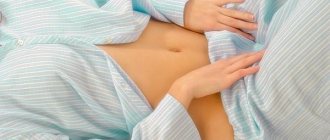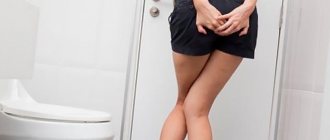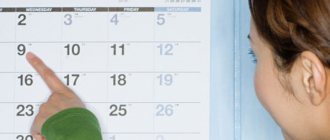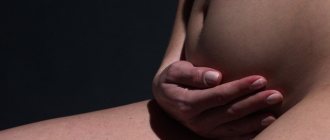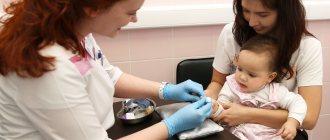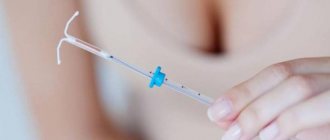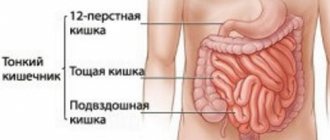Home / After childbirth / Causes and treatment of constipation after childbirth
6847
1
Throughout pregnancy, every woman experiences enormous stress. In addition, you have to conduct many examinations and take various tests. After the birth of a long-awaited baby, various complications may appear.
A young mother may experience varying degrees of discomfort: dizziness, heartburn, swelling, nausea, constipation after childbirth. Moreover, the last complication is the most unpleasant. This phenomenon refers to the passage of the process of defecation in a difficult or incomplete form; stool after childbirth can be hard and come out with blood.
Why do you have difficulty going to the toilet after childbirth and caesarean section?
Why is it difficult and painful to go to the toilet after childbirth? The reasons for this are often psychological. After a difficult natural birth with prolonged contractions, women develop a fear of defecation. They are afraid to push, they are afraid that it will hurt. If the woman in labor also received internal or external stitches, then this fear may increase due to fears that they will come apart. In addition, problems with bowel movements may occur for the following reasons:
- Hormonal changes in a woman’s body that occur during pregnancy.
- Hemorrhoids (more details in the article:).
- Poor nutrition.
- Weakness of the abdominal muscles.
- It is also common for women to experience constipation or diarrhea after a cesarean section. The cause of these disorders is the painkiller used during the operation.
With postpartum constipation, women in labor experience a feeling of heaviness, they are bothered by bloating and flatulence. In difficult cases, feces with blood appear.
If there are problems with your intestines, you need to take action. What to do and how to alleviate a woman’s condition? Is it possible to solve this problem with the help of medicines and folk remedies? The answers to these questions can be found below.
What to do?
This article talks about typical ways to solve your issues, but each case is unique! If you want to find out from me how to solve your particular problem, ask your question. It's fast and free
!
Many women after childbirth ask doctors an intimate question: how to go to the toilet without pain? How to avoid defecation delay?
First, let's figure out why constipation is dangerous. Feces retained in the body for more than 2 days contain toxins and poisons. They enter the bloodstream and pass into breast milk. Together with him, the baby receives substances that are dangerous to him. In addition, constipation does not negatively affect the condition of the woman herself. The load on the liver increases, weakness appears. The skin turns pale, and in some cases hair loss occurs.
In order to avoid problems with bowel movements, you need to eat right, drink the required amount of fluid, and lead an active lifestyle. If the causes of constipation are psychological, you need to try to calm down, relax, or consult a doctor so that he can prescribe sedatives.
If constipation occurs, you should consult a doctor for treatment. It will help you choose an effective way to fight:
- change in diet;
- taking medications;
- performing special exercises;
- use of folk remedies.
Proper nutrition for constipation
Constipation after cesarean section or natural childbirth is a common phenomenon observed in women in labor. Experienced mothers advise improving bowel function with proper nutrition. Including foods that normalize stool in your daily diet is the simplest and most harmless way to combat difficulty defecating.
The menu should include vegetables and fruits. They contain a large amount of fiber, which normalizes intestinal motility. However, you need to remember that diarrhea may occur when eating large portions of food recommended for constipation. Fruits and vegetables that promote normal bowel movements and are allowed during lactation are described in the table.
In addition, a woman who has recently become a mother needs to drink a lot of water. During breastfeeding, a woman's body loses a lot of fluid that needs to be replenished. Fermented milk products also have a beneficial effect on the intestines.
During constipation, you should eat often, but in small portions. White bread and fried foods should be excluded from the diet.
Drug treatment
If 3 days have passed after giving birth and your stool has not improved, you should seek help from medications. There are many effective medications for constipation that are allowed during breastfeeding. Most often, women use rectal suppositories or syrup:
- microenema "Microlax";
- glycerin suppositories;
- Norgolax;
- Naturolax;
- Mulcofalk;
- Lactulose;
- Lactipol;
- Duphalac;
- Normaze.
All of these medications affect intestinal receptors. They are not absorbed by its walls, which means that the medications are completely safe for the baby.
Most often, mothers prefer glycerin suppositories and microenemas. Their main advantages are fast action (10-20 minutes) and ease of use. After their use, diarrhea may occur, with the help of which the body gets rid of feces containing toxins and poisons. However, when choosing a drug against constipation, you need to carefully study the instructions, because all medications have contraindications.
Folk remedies
To prevent hemorrhoids from appearing after childbirth, a woman should not strain when visiting the toilet. How to adjust the chair? You can use traditional medicine recipes.
Remedies such as:
- potato juice;
- fig decoction;
- medicinal collection;
- herbal mixture No. 1 and No. 2.
The recipe for preparing a laxative medication should be checked with your doctor. He will tell you not only how to get a folk remedy for constipation, but also how much to take and for how long.
Special gymnastics
Performing special physical exercises is the simplest and most cost-effective way. Gymnastics does not take a lot of time, so it does not require changes to your daily routine. First, it will be enough to resume morning exercises. Before performing exercises, it is recommended to drink half a glass of warm water. If a woman’s health does not allow her to exercise at least 10 minutes a day (consequences of a difficult birth, stitches), then you can start with short walks. The duration of walking should be gradually increased (10, 15, 20, 25, 30, 40 minutes, an hour).
If there are no restrictions, you can choose a set of exercises for yourself that will help restore intestinal function. It should include swinging your legs, bending in different directions, and turning your torso. Then you can add breathing exercises.
Hemorrhoids have come out, a hemorrhoid has fallen out, what should I do?
Prolapse of hemorrhoids is a common symptom of complications in proctological diseases. What to do if a hemorrhoid prolapses?
- What to do if hemorrhoids come out unexpectedly
- First aid at home
- What not to do when the venous plexus has prolapsed
- Self-reduction of the node
- How to treat
- Prevention recommendations
- A node comes out during pregnancy: what to do
- How can a doctor help?
- What should a pregnant woman do before visiting a doctor?
- What are the dangers of prolapsed nodes during pregnancy?
- If the nodes were not corrected and labor began
Inflammation of hemorrhoids and their protrusion outward are the main signs of hemorrhoids. They can be very painful, bleed, and sometimes this condition is unbearable to endure. If in the first stages of proctological disease the nodes can be adjusted independently, then in advanced cases this is difficult to do.
What to do if hemorrhoids come out unexpectedly
The main thing is not to panic and not to touch the lump with dirty hands.
A person must:
- Contact your doctor. The faster he does this, the easier and simpler it will be to cure the disease.
- Relieve the condition before going to the proctologist. How to do this, read below.
First aid at home
If hemorrhoids come out, the patient cannot sit, lie, or stand normally, first of all it is necessary:
- Apply an ice pack wrapped in a soft natural cloth to the sore spot. You cannot simply apply ice to the anus, as this can freeze the tissue. The procedure lasts a few seconds.
- Take baths with cool water. Lower the basin into water (temperature 18 degrees) for no more than 10 seconds.
- Make baths from chamomile, calendula, oak bark. Sit in such a bath (water temperature 38 degrees) for up to 20 minutes. Herbs will soothe, reduce pain, and relax muscles.
- If a pharmacy is nearby, you can buy any anti-inflammatory ointment for hemorrhoids. It is necessary to lubricate the cones 3-4 times a day.
What not to do when the venous plexus has prolapsed
Many people think that it is necessary to move. Of course, physical activity is a method of preventing hemorrhoids. But when the venous plexuses have already come out, it is better to limit them.
So, if the nodes fall out, the patient is prohibited from:
- Walk. The patient should lie on his back, this reduces the load on the muscles of the rectal area.
- Use toilet paper. Only washing with running water at room temperature is allowed.
- Wear tight underwear, tight pants, shorts, as they will put pressure on the pelvic organs.
- Lie on a soft surface. The bed should be quite hard.
- Sitting on the toilet for a long time. If you cannot have a bowel movement, you need to give a laxative enema.
Self-reduction of the node
If hemorrhoids come out, they need to be corrected. This procedure must initially be performed by a doctor. Independent actions in most cases lead to disastrous results.
During the consultation, the proctologist will tell you and teach you how to perform the procedure at home:
- Wash your hands and put on sterile medical gloves.
- Lubricate the node with heparin ointment or Troxevasin for pain relief.
- Take a comfortable position and slightly tilt your torso forward. Spread your buttocks, feel for the hemorrhoid and gently press it into the rectum with your index finger. Squeeze your buttocks.
- Lie on the bed and do not get up for 20-30 minutes.
When adjusting the nodes, do not use excessive force.
And if after two attempts it was not possible to return the prolapsed venous plexuses, stop performing the manipulation. Contact a proctologist or surgeon.
How to treat
The most effective treatment for hemorrhoids is the advice of a good doctor. A thorough diagnosis allows the doctor to quickly eliminate the consequences and complications of the pathology.
At the initial stages of the disease, conservative therapy is used. This includes medication and physical therapy. Prescribed drugs for veins and blood vessels, creams and ointments, rectal suppositories, enemas, lotions, sitz baths, physiotherapy. In some cases, wearing compression garments can be very helpful.
If, after drug therapy, the nodes continue to fall out and sometimes cannot be reduced, surgical treatment is prescribed. The specialist chooses which type of operation to use individually. It depends on the severity, course and symptoms of the disease.
Prevention recommendations
When a specialist has reduced hemorrhoids, he must give recommendations to prevent relapses:
- Eliminate constipation. You can cope with fecal obstruction by consuming plant foods. The patient's diet should include vegetable salads, fresh fruits, fermented milk products, and oatmeal. A person must control the amount of liquid he drinks. Drink at least 2 liters of water per day. The liquid normalizes intestinal motility and relieves constipation.
- Strengthening the muscles of the anus. Squeeze and unclench the sphincter, do a “birch”, march, bend the pelvis, etc.
- Use of medicines. To prevent the problem from reoccurring, you need to regularly inject anti-inflammatory suppositories into the rectum. Be sure to lubricate the problem area with antihemorrhoidal ointments and take a course of phlebotropic medications.
- Physical activity. After the nodes have been adjusted, you can eventually begin physical therapy or sports.
A node comes out during pregnancy: what to do
Prolapse of the venous plexuses can occur in the early stages of pregnancy. But most often this pathological condition is detected in the last months. This is due to the fact that the enlarging uterus disrupts the blood supply to the vessels.
If the nodes fall out, a pregnant woman should:
- Contact your doctor immediately. If a woman does not do this, she risks complications during and after childbirth.
- To eliminate pain, take medications that contain lidocaine or anesthesin (in the first trimester). If the disease takes you by surprise in the second trimester, then you can use the drug Hepatrombin G. And from the third trimester you can take Detralex tablets.
Any medications for hemorrhoids during pregnancy should be taken only as prescribed by a doctor.
How can a doctor help?
When the hemorrhoids come out, the proctologist can apply minimally invasive therapy methods to the pregnant woman:
- Sclerotherapy.
- Alloying with latex rings.
- Laser exposure.
- Cauterization using infrared radiation.
These methods are the most effective in treating prolapsed hemorrhoids in pregnant women. Therefore, at the first signs of deterioration in health, contact a specialist. This is the first priority for a pregnant woman.
What should a pregnant woman do before visiting a doctor?
To alleviate the condition, a pregnant woman must adhere to the following rules:
- Maintain hygiene of the anal area.
- Drink enough liquid.
- Try to move a little.
- Eat vegetables, fruits, oatmeal.
- Adjust the chair.
- Perform a cleansing enema.
- If necessary, take laxatives.
What are the dangers of prolapsed nodes during pregnancy?
If the nodes bleed, the woman becomes anemic. And a lack of hemoglobin can lead to delays in the growth and development of the fetus.
If an infection gets into the prolapsed node, a purulent-inflammatory process appears. It leads to the fact that toxins and harmful substances will be absorbed into the blood, reaching the fetus. The child will be infected while still in the womb.
Considering the consequences that external hemorrhoids can lead to, women should contact specialists at the first symptoms of the disease.
When is it necessary to contact a proctologist?
Most women manage to get rid of constipation with the help of medications or folk advice. However, some experience complications such as:
- severe pain in the peritoneum;
- feces with blood;
- defecation delay for more than 2 days;
- More than 3 weeks have passed since birth, but difficulties with bowel movements remain.
If one of the signs is identified, you should contact a proctologist, because this may be a symptom of a serious disease (intestinal obstruction, tumor, adhesions). The doctor will prescribe an effective laxative that will help get rid of the problem.
What should you be concerned about?
In cases where your stomach feels tight after childbirth, and about a month has already passed, you should be more attentive to your health and not miss symptoms such as:
- general malaise;
- weakness and chills;
- temperature increase;
- change in the amount of discharge;
- change of their color to greenish or yellowish-purulent;
- heavy bleeding;
- the appearance of an unpleasant odor in the discharge.
All this may indicate an inflammatory process, which will be impossible to cure without a doctor’s prescription.
Prevention measures
How to prevent disruptions in intestinal motility? For preventive purposes, simple rules should be followed. Firstly, you need to exercise daily (morning exercises, walking, swimming). Secondly, it is necessary to adhere to proper nutrition; include in your diet foods and drinks that will help get rid of constipation and are allowed during breastfeeding. It is important to monitor the amount of clean liquid you drink (do not count soups, broths, tea, compote, juice).
A woman’s body prepares for childbirth in advance; usually, shortly before this, her appetite decreases and, accordingly, the need to go to the toilet. During the process of childbirth, when the fetus leaves the birth canal, a significant amount of feces is squeezed out of the intestines, which is why for some time after the birth of the child the woman does not feel the urge to visit the toilet; this break is especially favorable for those who have sutures during childbirth or hemorrhoids. Women begin to worry about how to go to the toilet in a big way after giving birth with stitches a little later. For many, the task is aggravated by the presence of concomitant diseases such as hemorrhoids, a tendency to constipation, and others. The use of laxatives is permissible only on the recommendation of a doctor.
What to do if you have painful bowel movements or constipation
Constipation and the pain associated with bowel movements are best prevented rather than treated. But if problems nevertheless begin, then the first thing you should do is figure out their cause.
If it hurts to poop and is constipated, then the first thing you need to do is change your diet, eliminating junk food and including more fiber. For problematic stools and hard stool, which causes pain, you need to:
- eat fresh plant foods daily;
- avoid dry food;
- resort to physical activity;
- add a few drops of oils (olive, flaxseed, pumpkin, etc.) to the prepared food;
- increase the amount of water consumed;
- eat dried fruits such as dried apricots and prunes;
- include fermented milk products without thickeners in your diet.
But what should you do if it hurts to poop due to a disease in the lower gastrointestinal tract or colon? In this case, treatment includes not only a special diet, but also medication. Therapy differs depending on the disease, so only a specialist can prescribe it.
If pain during bowel movements is caused by hemorrhoids, then you can help yourself with rectal suppositories and herbal baths, which the proctologist will recommend. In the case of tumors in the colon, therapy is more serious and should begin with a visit to an oncologist.
First visit to the toilet after childbirth
One of the ways to go to the toilet in a big way after childbirth with stitches and a rupture of the perineum is to take a wet napkin, fold it in layers several times and firmly, but painlessly, apply it to the perineum. Such support is important so that the seams do not come apart, the woman is more confident and calmly does her job.
If it doesn’t work out right away, it’s better to postpone this matter, but not for too long so that you don’t have to resort to more radical methods. With prolonged abstinence, feces become compacted, driven deep inside, and it becomes more and more difficult to get them out. And since the abdominal muscles are stretched, it becomes increasingly difficult for the intestines to fulfill their role. Therefore, doctors recommend running to the toilet in a big way at the first urge, even if the baby is feeding at this time. Otherwise, you can wait a long time for the next calls.
If you have hemorrhoids, you should not eat bread immediately after giving birth - it contributes to constipation. A woman should not be very nervous and worried, because this also causes a delay in bowel movements.
For existing hemorrhoids, relief, duphalac or sea buckthorn suppositories are used. Diet is especially important in the postpartum period. To avoid gas and colic, your child should not drink carbonated drinks and completely avoid grapes, legumes and rye bread. Gases are almost always an integral part of hemorrhoids. If it is not possible to get rid of them, then the drug espumizan is used as a last resort. Sometimes doctors prescribe enemas, but they do it once and in extreme cases.
Difficulty going to the toilet after childbirth
The problem of constipation after childbirth often occurs because after childbirth, intestinal tone decreases due to relaxed abdominal muscles. Other causes may include difficult childbirth, large blood loss, the use of painkillers or those containing iron, or the use of obstetric forceps.
Another important point about how to go to the toilet in a big way after childbirth with stitches and hemorrhoids is that when emptying the intestines, you should not make strong attempts, everything should happen calmly and without tension.
In addition, it is aggravated by the present psychological fear of the woman herself and her fear of tearing the stitches or disturbing the hemorrhoids. But here the body again shows miracles of adaptation in extreme conditions: during the process of natural childbirth in women, the nerves of the perineum are slightly “muffled”, pain sensitivity is significantly reduced. The changed hormonal background helps soften the stool and, even if the woman in labor had problems with stool before childbirth, she will most likely get rid of it after it. Breastfeeding promotes the production of the hormone oxytocin, which activates the intestines and, if a woman responds to the urge in time, defecation occurs painlessly and gently.
The most common problems of women in labor
Immediately after childbirth there are difficulties with urination. It is not for nothing that women are often given a catheter, because the accumulation of urine is harmful, since the bladder puts pressure on the uterus, and there is no opportunity to go to the toilet. It feels quite strange: you want to go to the toilet, but an attempt to relax the muscles of the perineum is not crowned with success, or is accompanied by pain. Urination is prevented by spasms of the urethra and the bladder itself, which occur quite often. Pain also occurs when urine comes into contact with injured genital organs: the vagina hurts after childbirth, and a strong burning sensation is felt. But these difficulties pass after a few days. It’s enough not to lie around, start moving actively, overcome pain and fear and urinate several times.
It is much more difficult if there are difficulties with the toilet “for the most part”. Constipation after childbirth is very common, and may not stop after a month or two. Going to the toilet for the first time can be simply scary: during contractions, the genitals feel such pressure that even the slightest tension causes pain. If there are stitches on the perineum, then this is even worse. In addition, the intestines themselves do not work well after childbirth, and weakened abdominal muscles do not help with this. But the problem cannot be neglected, since the lack of regular bowel movements negatively affects all internal organs: the intestines compress the uterus, and the feces themselves lead to intoxication. Therefore, one of the important tasks facing young mothers is to improve bowel movements and prevent constipation.
When you can’t do this on your own, doctors will help. Therefore, you should not think that if it hurts to go to the toilet after childbirth, then this is something shameful and it is better to continue to suffer than to consult a doctor. Regardless of the reasons for which this happens, not only a few people go through this. And it’s better to overcome embarrassment and get rid of the problem than to carry it inside yourself, continuing to harm your health.
What to do? How to go?
When a woman tries to relieve herself, there are some tricks on how to go to the toilet in a big way after giving birth with stitches. Even the posture of the emptying process itself matters. For the greatest comfort, it is better, while sitting on the toilet, to place some object such as a stool or box under your feet, and rest your elbows on your knees - in this position the rectum is in the most relaxed state.
If you suspect an anal fissure, you should immediately consult a specialist.
If nothing helps and the woman feels it is difficult to go to the toilet after childbirth with stitches, and the suspicion falls on constipation, then you can try to get rid of it with the help of special exercises, for example, “vacuum”. In a lying position on a hard surface, it is as if all the contents from the abdomen are inhaled into the chest. When you inhale deeply, the ribs should move apart, and when you exhale, do your best not to let them come together again, trying to spread them even wider. The stomach seems to “go” under the ribs. Repeat this several times. In addition to solving the problem with stool, this exercise has a powerful healing effect: after childbirth, the abdominal organs will return to their original position, blood supply to existing hemorrhoids will improve, and the pelvic floor muscles will receive the desired relaxation. Among other things, the “vacuum” exercise will help restore a woman’s flat stomach.
When bowel movements are delayed, it is useful to walk a lot, but do not overwork, do not sit on the toilet for a long time and do not strain.
We should also not forget about the diet of the woman in labor, this is the key to health - for her and the newborn. Pay special attention to drinking plenty of fluids: at least 250-300 ml of liquid in the morning, up to 10 glasses during the day. It is very good to include juices with the pulp of plums, apricots, tomatoes and add a few drops of any vegetable oil to them. You should drink such juices in the morning and before bed.
Eat fresh, non-mealy vegetables (without starch), non-astringent fruits - prunes, dried fruits, apricots, apples. The fiber content of whole grain cereals and bran also promotes regular bowel movements in the postpartum period. But after eating them, you need to drink enough liquid. To avoid constipation in the postpartum period, you must completely avoid chocolate.
In combination with all of the above measures, doctors highlight the particular importance of physical activity, it helps restore relaxed abdominal muscles, strengthen intestinal tone and the kilograms gained during pregnancy. Even if it’s difficult to move at first, you still need to find the strength to gradually increase the load, only in this way can you recover from childbirth and go to the toilet without any problems after childbirth with stitches and complications.
Almost every woman, after giving birth to a child, experiences fear, discomfort, psychological problems and other difficulties with the toilet, because going to the toilet after childbirth is not only scary, but also quite painful.
The problem with the toilet after childbirth is a separate issue that certainly deserves attention, because for some women the process called “going big after childbirth” is equated almost to childbirth itself. Therefore, let's take a closer look at this topic, find out all the main reasons why it hurts to poop after childbirth, and also analyze all the ways to go to the toilet after childbirth without experiencing pain and without provoking other serious consequences for your own health.
How to tell if your baby is in pain when pooping
Problems with bowel movements in children occur quite often, and constipation can occur constantly or appear unexpectedly. Most often, the absence of stool and pain during bowel movements bother newborns and children under three years of age.
If an adult child is able to independently report the presence of pain, then problems arise in this regard with small children. The fact that it is painful for a child to poop can be determined by the following signs:
- fear of defecation;
- cry during bowel movements;
- release of hardened feces;
- cry while wiping your butt;
- fear of the potty.
In addition, you can suspect that it is painful for a baby to defecate not only by restless behavior, but also by the presence of anal fissures and blood in the stool itself. These signs indicate constipation, so you should take a closer look at the child.
Sometimes pain during bowel movements can occur even with soft stool and regular bowel movements. Most parents are misled by this; for a long time they cannot understand the reason for the child’s hysteria during bowel movements.
If it hurts a child to poop, what should parents do to make it easier? First of all, you should pay attention to the baby’s diet. With a balanced diet and proper drinking regimen, children rarely have problems with bowel movements. If this is not enough, then the child must be shown to a doctor.
Why do toilet problems occur after childbirth?
If it hurts to poop after childbirth or when a young mother begins to notice that she is pooping with blood after childbirth, the reason most often lies in postpartum tears and surgical sutures placed on them or in the appearance of postpartum hemorrhoids.
How to poop after childbirth? - a particularly difficult problem to solve for those, as already mentioned, who are faced with hemorrhoids or postpartum sutures. If a woman is faced with both of these problems at the same time, then the task becomes significantly more difficult, but not impossible. The optimal solution would be to prepare the perineum for the onset of labor, and begin treating hemorrhoids during pregnancy, but if it’s too late to talk about this, then you should start making a decision based on the situation.
“Why do I poop blood after childbirth?” - a frequently asked question among women in labor. You won’t have to look for an answer for long, because blood during bowel movements after childbirth is a consequence of a hemorrhoidal fissure.
Why does it hurt to poop after constipation?
Most often, people who have problems with bowel movements complain of pain during bowel movements. This is due to the uneven release of feces, which, when left in the body for a long time, lose moisture and become harder and denser.
It hurts to poop after constipation because the anal area has many nerve endings. Injury to the walls of the colon and the anus itself leads to the formation of wounds that do not have time to heal before the next bowel movement. Therefore, the pain is often recurring.
Pain during bowel movements due to constipation is also observed due to the following pathologies:
- sphincter rupture (occurs when a person pushes too hard);
- damage to hemorrhoids;
- anal fissure;
- anococcygeus pain syndrome;
- cryptite;
- paraproctitis, etc.
Constant pain is observed with chronic constipation, accompanied by partial passage of feces. As they make their way, hard feces re-injure the walls of the intestine and anus each time. This prevents the wounds from healing, and the pain becomes more noticeable each time.
In case of inflammation of hemorrhoids, blood may be present in the stool. The pain itself during bowel movements has a cutting-burning nature, which is why a person tries to restrain the urge to defecate, which only aggravates constipation and pain.
Toilet after childbirth: hemorrhoids and constipation
Constipation after childbirth is the second most difficult problem to solve for women who have recently given birth. Often, after giving birth, a young mother is haunted by the feeling of fear that the stitches will definitely come apart during a trip to the toilet. In this case, the problem lies precisely in the psychological suppression of the natural need to empty. The consequence is the accumulation and compaction of feces, which provokes the formation of constipation. In addition to this, after childbirth, the abdominal muscles are often unable to perform fastening and squeezing functions, and the intestines also function poorly.
To solve the problem of postpartum constipation, first of all you need to overcome your fear and fear of the toilet, and also follow the following recommendations:
- Try not to be nervous, don't worry. Everyone knows how the intestines are able to react to our psycho-emotional state. Some thoughts make you immediately run to the toilet, while others, on the contrary, tend to cause prolonged constipation.
- Eat as much fiber as possible: eat fresh vegetables and fruits. Prunes and other dried fruits help a lot. If you have a desire to add bran to your daily diet, then you should definitely consult your doctor first and together with him choose the optimal amount per day. In addition, the doctor must recommend the amount of liquid, because bran must be washed down well. It is forbidden to consume chocolate, as it tends to lead to even greater constipation.
- In order to completely get rid of postpartum constipation, try to drink more water (or other acceptable liquid). Make it a rule to drink a glass of warm water every morning on an empty stomach. Throughout the day it will be useful to consume a decoction of prunes or dried fruits.
- Try to be mobile. During movements, our internal organs begin to involuntarily massage the intestines, which helps to improve its functioning.
- Go to the toilet in large quantities even at the slightest urge. This must be done even while breastfeeding or as soon as the desire to visit the toilet arises. You need to know that if you hold back the urge, the next one may come only after a few days, which will, again, lead to the formation of constipation.
- You should not push while sitting on the toilet, because such actions can lead to the appearance of hemorrhoids. As a last resort, you can try an enema. Also, under the supervision of a doctor, you can start taking special laxative medications, the lactation period for which is not a contraindication.
Causes of pain during bowel movements
It is very difficult to give an unambiguous answer to the question of why it hurts to poop. The problem can be provoked by both external factors surrounding each individual person and features in his physiological structure.
In addition, the process of defecation is influenced by lifestyle and the presence of bad habits. So, for example, people who drink alcohol, spicy foods and those who eat dry food more often than others complain of constipation and pain during bowel movements.
The following factors can provoke painful sensations during defecation:
- lack of fluid in the body;
- the presence of an inflammatory process in the colon;
- haemorrhoids;
- dysbacteriosis;
- long-term use of certain medications;
- physical inactivity;
- consumption of foods that increase gas formation in the intestines;
- lack of fiber in the diet.
Most of the above factors negatively affect the structure of feces: feces harden and become stone-like, so their release is accompanied by unpleasant sensations.
It becomes very painful to poop when the movement of the hardened accumulated masses damages the walls of the colon and leads to rupture of the anus. Such bowel movements are often accompanied by bloody discharge, and each subsequent trip to the toilet causes repeated pain until the previous injuries heal.
How to go to the toilet after childbirth?
First of all, if you have stitches, hemorrhoids, or a tendency toward constipation during or after pregnancy, then you should not overuse fasting foods. For example, do not pounce on baked goods, which are often served in maternity hospital canteens.
Secondly, toileting after childbirth appropriately involves the use of glycerin suppositories or the drug Duphalac. These products will ensure that you do not have to strain while you are on the toilet. If a woman suffers from hemorrhoids, then it would be advisable to use suppositories for this disease. In addition to using medications, it is also recommended to take care of a special diet that can help prevent constipation.
Another difficult problem associated with going to the toilet after childbirth is the formation of gas in the intestines. Gases, just like feces and urine, prevent uterine contractions during childbirth.
To prevent this problem, you should follow the following four rules:
- Eliminate from your diet foods that provoke the formation of gases in the intestines (fresh grapes or raisins, brown bread, dairy products, legumes), and also lead to colic in the child.
- For preventative purposes, brew and drink tea from dill or fennel seeds. In this case, you will not only prevent the formation of gases in your intestines, but also prevent the occurrence of colic in your baby.
- If gases still begin to bother you, then, after consulting with your doctor, you can start taking Espumisan.
- When neither suppositories with glycerin nor dill decoction help, then most likely the matter lies in the psychological aspect. Regardless of how the baby is born (cesarean, with tears, with incisions, or naturally), a woman almost always finds it difficult to poop after childbirth. In order to eliminate the possibility of complications, it is best to first use “natural” methods of cleansing the intestines:
- in the morning, eat oatmeal cooked in water;
- In the evening, consume kefir with prunes.
In turn, doctors additionally recommend trying to move as much as possible, even if it is difficult for a pregnant woman to do so. It is the movements that help restore contractions of the smooth muscles of the internal organs and help well in solving the problems described above.
Constipation for a few days after your baby is born is normal. In the maternity hospital, you may feel uncomfortable going to the toilet. In addition, it is quite natural to feel some fear of walking in a big way if you have a baby after giving birth. As a result, you may experience constipation in the first days after your baby is born. There are several physiological causes of constipation:
- Levels of the hormone progesterone that increase during pregnancy may continue to affect you after childbirth.
- During childbirth, the digestive system slows down.
- You may have taken medications such as pethidine. These medications may slow down your bowel movements.
The risk of constipation increases if:
- During childbirth, doctors used obstetric forceps and a vacuum extractor;
- This is not your first birth;
- you take iron tablets or antidepressants;
- you have stitches.
Will it hurt to walk big?
Most likely no. You may feel that the area between your vagina and anus (perineum) is numb. This is because the nerves in and around the vagina are stretched after childbirth. Therefore, when you go to the toilet for the first time, you are unlikely to feel anything. Worrying about bowel problems can only make the situation worse. When nervous, the anus contracts instead of relaxing. So try to distract yourself. While on the toilet, you can read a magazine or book. If you have stitches, don't worry about them coming apart. On the contrary, the risk of suture rupture increases in the case of constipation, which stretches the pelvic floor.
Main causes of pain
- Endometritis.
- Salpingo-oophoritis.
- Other inflammatory diseases.
- Seams.
- Anal fissures.
- Haemorrhoids.
In most cases, abdominal pain and difficulty going to the toilet are not signs of the same disease. Pain can occur due to incomplete restoration of the uterus, or due to disturbances in this process, while constipation can be caused by changes in hormonal levels, poor nutrition, impaired peristalsis, and psychological problems. The fear of the toilet is sometimes more difficult to overcome than physiology itself. Therefore, if a month after giving birth the lower abdomen hurts, and at the same time there are still difficulties with bowel movements, then the reasons for this should be dealt with comprehensively.
How to deal with constipation?
After giving birth, try to start eating and drinking regularly as soon as possible. It is best to eat fiber-rich foods, fruits and drink plenty of fluids. Water makes bowel movements easier. The air in maternity hospitals is often dry, so you may become dehydrated unnoticed. makes you thirsty, so you need to drink plenty of fluids. After giving birth, start walking around the room as soon as possible. Sitting or lying down for long periods of time only increases the likelihood of constipation. When you feel the urge to go to the toilet, do not tolerate it. Sit completely on the toilet rather than sitting over it. (Some women choose not to sit on the toilet entirely in hospital restrooms.) Once seated on the toilet, place your toes on the floor and lift your heels. Your knees should be slightly higher than your hips. If possible, place your feet on a small stand to elevate your knees further. Place your elbows on your knees. The position you need to take should be similar to a squatting position - this is best for bowel movements. This is why some mothers prefer to use a baby potty after giving birth. Then you need to bend forward and straighten up several times so that your abdominal muscles begin to work. As you perform these movements, you should feel the muscles alternately contracting and relaxing. Fold a sanitary pad in half and place it on your perineum or where you have stitches. This way you can support your pelvic floor without worrying about the stitches coming apart (they won't). Once the nerves in the perineum have healed, you may experience pain when defecating as the perineum and pelvic floor lower when pushing. Holding the pad in place as described above will support your pelvic floor and relieve soreness.
What to do if all attempts to go to the toilet are unsuccessful?
Pushing and straining will not help relieve constipation, but may cause pain. Try the following exercises:
- put your hands on your stomach;
- pull your abdominal muscles in so that your stomach becomes flat and wide;
- then do the opposite: relax your muscles and stick out your stomach;
- retract and protrude your stomach 10 times, the last protrusion should be longer and last about three to five seconds.
- During the last protrusion, relax your pelvic floor. At this point you should feel movement in your intestines.
- If nothing happens, don't push. Try doing a few more retractions and protrusions.
- If still nothing happens, do some pelvic floor exercises and try going to the toilet later.
You may notice that if you eat something or drink a large glass of water or juice, your urge to pee increases. A strong urge may appear after about 15-30 minutes. You should not sit after eating or drinking; it is better to walk a little. If you do not have a bowel movement within three days, consult your doctor. He or she may prescribe a laxative to stimulate your natural digestive rhythm. Laxatives provide temporary relief, but may cause minor cramping in the abdominal area. First, your doctor may prescribe a laxative in liquid form. If it doesn't work within three to four days, your doctor will suggest you try laxative suppositories. It is very important that your doctor gives you a prescription for a laxative and that you do not buy it yourself. The drug you choose depends on what medications you are taking and whether you are breastfeeding. Here are some tips to help prevent long-term constipation:
- When you feel the urge to go to the toilet, do not tolerate it.
- Do not take medications that may cause constipation as a side effect. These medications include, for example, painkillers, so consult your doctor before taking them.
- Eat regularly and eat plenty of fruits and vegetables, and drink plenty of fluids.
- Do it daily. For example, walking with a stroller is quite suitable.
- Talk to your doctor if you have hemorrhoids or anal fissure. Both of these conditions can worsen constipation
